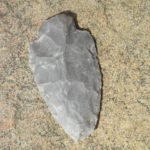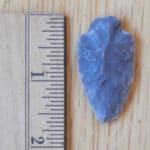Arrowheads at Watoga
Background
Consider the trails currently existing in Watoga State Park. Some of these are assumed from existing pioneer trails. And those early but historical trails may have been appropriated from trails trod by the ancients. We now call them Native Americans. After all, the terrain forces us to take the path of least resistance. So it is reasonable to assume that there is a certain logic to the path one takes to get from one place to another. Trails were important to ancient people for hunting, trade, socializing and annual migrations.
So I was not surprised when I found an arrowhead on Monongaseneka Trail recently. Finding an arrowhead is a singularly profound experience. Consider the last human to touch it was an Indian who lived and hunted in these mountains hundreds, if not thousands, of years ago. So, what can we infer about this person by the artifact that he left behind?
Details of the Found Arrowhead
We may be able to determine an approximation of the age of the point by the material it is made of and its design. This point is a stemmed point referring to the square elongation at its base. The color and quality of the flint suggest it may have come from flint found in the Lewisburg area. And finally the design indicates it may be Archaic, a group of Native Americans who lived in settlements in our area in the period from 9000 BC to 4500 BC. An archaeologist or a collector may have more accurate information. But it is probably not a tool that belonged to historic native groups, such as Shawnee.
Is it truly an arrowhead ? Was it attached to an arrow shaft and shot from a bow? Probably not. Only a small percentage of flint points were used on arrows. Furthermore, it was not until about 1400 years ago when the bow and arrow found its way to the western hemisphere.
Flint points were manufactured for a variety of uses including scrapers, knives, bow drills for making fires and drilling holes, and for spears. This point may have been a spear point, meaning it is attached to a wooden shaft and cast using a spear thrower called an atlatl.
This fine point is on display at the Watoga Nature Center. It is a reminder of the people of many purposes, languages and customs who traversed these same mountain trails that we do to this very day.
It goes without saying that the removal of any historic or prehistoric artifact in any West Virginia State Park is unlawful and deprives the public of its cultural value.

